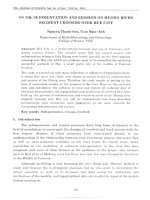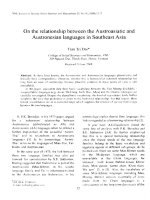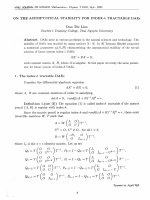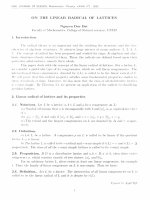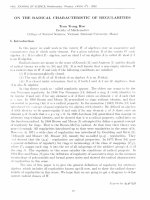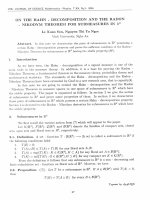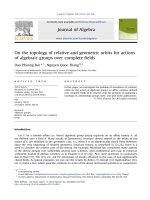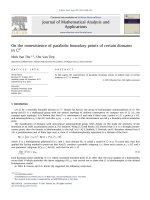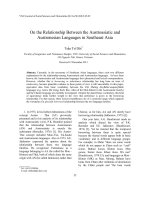DSpace at VNU: On the mean absolute deviation of the random variables
Bạn đang xem bản rút gọn của tài liệu. Xem và tải ngay bản đầy đủ của tài liệu tại đây (3.87 MB, 9 trang )
VN U , J O U R N A L OF SCIENCE. (Mat, Sci., J
X V . n®5 - 1999
ON TH E M E A N A BSO L U T E D EV IA TIO N
OF T H E R A N D O M
V A R IA BLES
T ra n Loc H u n g
Department of Matiieiimtic
College o f Sciences Universitv o f Hue
P h a m G ia T h u
De pm tĩnent o f Mãtheiìiíìtic mid Statistics
University of Moiictoii, Moncton, C huhcI h
A b s t r a c t : The m ain object of the study is a measure o f dispersion, is nam ed the
Mean Absolute Deviation (or A4AD, fo r skort) o f a random variable X, ỗf^{X) =
E{\ X -
\). The basic properties of the M A D and som,e detailed computations
on t,he M A D are established. We also focus
Oil
the applications of the M A D in the
Limit Theorems, when the role of the stmidard devĩaỉìon Ơ^ { X) — [ E { X —
is p l a y e d by Ỗ ^ { X ) .
1. IN T R O D U C T IO N
Let X be a random variable with finite mean E ( X ) — ỊI. T he stan d a rd deviation
of X, denoted by Ơ^ { X) — [ i ’ivV “
is very weil-kiiown in tlie probabilistic and
statistical literature as a moasure of (ỉispeisioii. Especially, its wide-spread use has
presented in theory of limit theoienis, ill sampling thooiy. ill th e analysis of variaiico aiul
statistical decision theory (see [1], [2], [3], [6] an(i [71 for coniploto bibliography).
O n the u l h f i ha n d , althuu^l i phiVtij^ a dumiiiaiil luh* Hi fuiKtioiial analvMii, Tiic
mean absolute deviation (or MAD, for short) of X. (li'notrd by
seen relatively few applications ill probability iiiul s ta tis tic s
6 a{ X)
= E(\ X — ụ I), lias
In tho traditional terniinolo^\'.
is said to be the firsi absolute Iiioinont of a rantloin vai'iabl(‘ X {sec [1], [2j. [.'i^ Hiul
8] for the definition). Probably, their coinputaiioual complexities are not convenit'ut to
use, especially when the random variables are discrete (see for instance Section 2).
However, from the inequality
< ơị ^{X) for an a rb itra ry random variable X
(see Proposition 2.5), the question arises as to w hat happens if the role of the stauclard
deviation Ơ^ { X) is played by
In recent years some results concerning th e M AD have been investigated by P ham Gia THU, Q. p. DUON G and Ttukan N. . . . in some topics of statistics, econometrics,
reliability theory and Bayesian analysis (see [4], [5] and [6] for more details).
T he main aim of this note is to present the basic properties of the M AD of a rand om
v a r ia b le a b o u t its m e a n ổ ^ ị X ) a n d a p p l i c a t i o n s in t h e lim it t h e o r e m s , w h e n t h e ro le o f
36
O n the m e a n a b so lu te d e v i a t i o n o f the...
37
t h e s t a n d a n l d e v i a t i o n ơ f ^ { X ) is plavtnl by
Mo i( ‘ specificallv, in Sort ion 2
and
SOI I K' i l l u s t r a t i v o
co n ip u tatio n s
W(‘
li'view
iiu MADs
S 01 1 K'
a i(‘ also
o f main pi-OỊ)<'iti('s of th(' /5;, (.V)
piT S i'iitO ii ill t h i s
S i H ’t i o n .
Th('S(*
rosults aro I('C('iv('(l [)V using tli(^ Li'iiinia 2.1 in S(*ction 2 iiiid ilu'v are iiuh'ix'iuli’iit with
O I K ' S of Pliani-G ia TH U and Tiiikan X in [4]. [5] and [G]. For making the im portant role
and usefulness of the M ADs Iiioif* apparent, in the Section 3 W( ' will consiclei some results
(■onc erning tlie limit hf'haviouiH of the Bernoulli and Poisson distributed random variables.
In addition, soino results on Weak Laws of Lai f^o Numbers, where the classical conditions
aio (liroctly iiuposcil on the
are also established.
It is worth pointing out that the ĩocpived results from the Leiinna 3.1 and Theorem
3.3 in la,st siH tion only are i(‘foiinulatioiis of the well-known classic Weak Laws of LaVge
Nuniỉ>ers (\V(^ refer the readers to [l]. [2]. [3], [7], [8] and [9]), but we (lid not really have to
use the assum ption on indopeiulence of thí' landoni variables. In addition, the existence of
rho first absolute Iiioiiiont (the m ean absolute deviation) in replacing the second moment
(the s ta n d a rd deviation) is to be in concord w ith som r practical piobleins.
2. SOME COMPUTATIONS o x THE MADs
Th iu u g h o iit this pap(M‘ \V(‘ shall coiitiiiiu' using the
notations an' as in [4], [5] and
6]. Let
= £ ’(| X - a \) denote the M AD (about an arbitrary the point a) of a
raruloiii variable X.
(I — E { X ) — /J, wo have tlu‘ MAD about thí' mean, donotoi! 1)V
ốị, {X), and for (I — Mi l { X ) (wlioro M d { X ) denotes the iiKHlian of X) we havf' the MAD
ai)oiit the uK'diaii,
by
V)At Hist \V(‘ will i v v i e w SOIIK* basic properties of the
and ố!\Ị^Ịịx)-
P r o p o s i t i o n 2.1
(i)
> 0 foT (IUỈỊ raiidorn variable X and f o r all points a G ỈR.
(Iij Ờ Ị , ( X
-t-f/) — d f^^ (X) f o i
')l.
—I r I ỗf ^(X) f o r (liiij real
(iii)
(iv)
(v) For
all n t
CLĨI
< ^ p { X) +
f o r two arbitrary randoin variables X and Y.
arbitrary raiuloni variable X
Proof, (i). (ii), (iii) and (iv) will b(‘ proved by using the direct com putations from the
cl(*finition of the
For gettin g (v) we first observe th a t the m edian minimizes the
average absoluto distanco (see [1, p .201 ] for definition of the median), so we have
^Md{X) s à^,{X)
for all X.
The second p a rt of t h è inequality, à^^{X) < Ơ^{ X) , is obtained from the well-known
Schwartz inequality (see [7] for m ore details). Ộ
38
lY a n Loc Hung, P h a m G i a Thu
L e m m a 2.1.
Let X be a rmìdoììì variahie ĩinth the disfnbuiton function F x { ^ ) ‘ S u p
pose that tfic ineaĩì E { X ) — fi e.rits. Then
^ 2 /
(■'■ -
and forthe raiidoni variable X
^
is discrete witli the (listiihiitions Pa-
k
^x(X ) -
I
(1)
'r<ịi
{Xị,--
I t a - - / ; I Pa- = 2 ^
Proof. By virtue of
(/' - ■i')
= 2 /
i '>fi
= 2 ^
k-.Tị,>fi
~ P { X ~ Xk } \ k > 1.
- :rk)Pk-
(2)
k':.rị,
- M)(ỈF\(.r) ~ 0 it follows that
(.r - f t ) dFx { r ) +■ /
(/i - :r) dFx{r) = 2
'f.r<ị£
I
{x ~ f i ) d F x { x ) .
In t h e s a n i o i n a n n e i W(‘ r a n s h o w t h a t
^ .( A ') = 2 /
(//-.r)r/F .v (.r).
Similar aigunients apply to the case tlu* raudơni variable X is discrete w ith the
distributions Pk =
p{x
— 7 a }, A’ > 1,
= X! I
I
^ ^
{■n - ụ ) p k = i‘
^
Ui ~x k) ph-
Ả ':.ỉ>/
and This finishes the proof. <0>
It is to be noticed th a t se(*niiiiglv the foiniulac (1) and (2) are m ore easier to apply
for com putations on the MADs th an wt'll-known result which is duo to P h a m -G ia TH U
and 'ruikan N. in [5j. This is tlio main caiisr th at wo shall use the formulae (1) or (2) for
com puting th<^ MADs ill íh(' iH'xt (haỊ)t(ns. Tlií' rosiilts ill Iii'xt section have been obtaiiiPil
indepoiulrntly, if ('onipart' with OIK'S in [4], [5] and [(i .
P r o p o s i t i o n 2.2.
Let X be a general, uniform random variable (see the Table
[6 ]) with the density functAon
6ẻz-
rf^e{a,b)
0,
if X Ệ
(a,
b)
and the mean E { X ) = 2 ^ . Then we. have ốịỊ^b{X) = i ( 0 - o).
Proof. By virtue of (1) it is obvious that
It is worth
Iioticiuii, that,
if b = f) + a then
ố^ịX) = I
is same result in [6].
<c>
1
in
O n the m e a n a bso lu te deuiatioii o f the,.,
39
L(‘t X h( a. poiix r iinxio'iii iHirnìhỉc ir/fh fh( <ỉ( ììSiìỊỊ fiiiict/oii (scf:
P r o p o s i t i o n 2.3fh.f Tabl f ' I IV ỊOỊ)
/{.;■: n ) = n.; '‘ ‘ . o X ) , 0 < ,/■ < i.
I'fien
n -f 1
o -f 1
Proof. ApỊílvin^ ílu' f'onnnla (1) witli th(' ('xp('Ctatioii E { X ) — 1^1 .rf{.r:a)(l:r — —
to
uhíaiỉì that
^ ,(.V ) =
•■ ■ ■
2
2
_ ,r ) a ,r " - 'r /.r =
./()
rv -Ị- I
'> + 1
,
a
a
I
Tli(' p i o o f is couipli'rod and ỉiií' r('i(MV0 (l msult is as in [6] hut 1)V short way. Ộ
Let X he an e.rpmitnf'ial randavi VdTuihle with the deji.siiy functurn
P r o p o s i t i o n 2.4.
f.sf'i: t ỉ i f :
Ịdỉìỉc
1 /fi
lúị)
f { r : X) =
> (). .;■ > ().
Tỉicn
t i ị X ) = 2r
‘ = 'Ir ‘r7i(.V).
V
V
Ị^ivoỊ. \ \ v now a])])l\' tli(' íoỉ inula (1) u^aiĩi witli tli(’ ('X])('ctati(>ii E { X ) —
IA aiul íli(’ staiulai(! (l('\‘iaTioii ơ iy( A ') — A lo obfaiii that
^ ị(.Y ) = 2
'
I
(.r -
/ 1
■ A
‘ )Aj-’r' '"•’ilr =
2
r ' X ' = 2<.' 'a ị ( . V ) ,
A
'
I hi' p r o o f is c u n i Ị ì l c t c d a n d lh ( ' 1('C ('i\('(l K 's n lt is as ill [(rl a n d in Í8, p . 2 2 4 ].
P r o p o s i t i o n 2.5.
d-i' —
Ộ
Let X be a gamma distributed random, variable with the density
f i n i r t u n i (ĩtee T a b l e I i v [6Ì. M o d e J 6 o r [4]).
/ỉ" r(n )
U'hert n . 3 > 0. .r > 0 and r(f>) —
à,ÁX) -
where ụ = E { X ) = (\3.
(/(iiti'i'ia furictKjii. Thev
'
2 a '\i
-e 'T ( a )
Tran Loc Hung, P h a m G ia Thu
40
Proof. It
I(a),/o
Not(' t h a t \V(‘
p
r(o )
USÍHỈ Fir) + 1) ~ o F i o ) . A]:>plyiui2, (1) Hiul a (liii'c! I'oiuput at ion
sho ws tliat
This completes the proof. <c>
P r o p o s i t i o n 2.6. Let A’ bf' a random t^dTtable of Pareto tỉỊịHi- Ị
Ịỉ: p. 275] f o r detatl.s) Wifit ffie. (huisitij f'lnictujii
Ị6: Table ỈỊ Oi
/(,/•; ,r,). a ) = o.r(‘} , r - < " + a > i. .r > .I’o > (3.
Then
where /i = E { X ) =
Proof. It can he verified that
fi = E { X ) =
r ^ a r i;r -'',l:r = ^ r o .
I ,
n - 1
Taking (1) m to account W(‘ g('t
Ồ, AX) - 2 / ”“ '
■'h,
- 2.ro(o - 1) - ‘ (1 - a - '
.
''
1
The pioof is sti ai^lii-foi ward. Ộ
P r o p o s i t i o n 2.7,
Let X bt: a Poissoii disirilxiicd Ỉ(ui(ỉ()ifi (uiruihif’ (Ijilit fhe po.sftn'i.
ừdeger-vaỉue mean E { X )
n . n > 0. Thtii
0„{ X) ^ 2 n c - " ' ^ ~ J ị v = c j „ { X ) J ị ^ 0 . 7 d 7 8 8 ơ „ { X ) .
fi]
\ ' 7Ĩ
V 7T
where the sụpt ^
ÌÌ —^ -j-oc.
is used to liidicafc that thf! lafio of Ỉỉic t(V0 sỉdcs tffids fo (ui/tiỊ (LS
Proof. N o te tha t, \\ip varianci' a^^(A') also is the positive int(‘gri-valu(‘ //.
By (liiectly using iiw fonnula (2) from Lem m a 2.1 wo will show th at
0
„ ( X) =
2
y (n -k )c -"~ =
h'l
2
nr~"-^.
//!
O n the m e a n absohite d e v i a ti o n o f the,,.
Using tho Stirling's foiiiiula //! = \ / ^ n "
sions), W(* ^(’t.
Ỉ
, (s(H* [2; p. 50] for (ỉ('taiỉ('(l tliscĩỊS-
;/!
w h i U P t h e siftii
ỈÌ —» + 0 0 . Ộ
For tlu'
is u s e d t o i n d i c a t e t h a t
case, wo not(' th at as
E
t h e r a t i o o f t h e t w o s i d e s t t ’i i d s t o uriit.y a s
11—» +
- V- MI
ơ „ (X ) I
00,
/2
V
7T ’
where Ị-1 = E [ X ) is the mean of X anil ơ' Ì {X) is the vaiiancp of X.
P r o p o s i t i o n 2 .8 (see [2, piohloin 35 p .226
Lei S ,1 be the number o f success in n
Bernoulli trials with the inejiii E{ S n) = 1>P and the variance ơịj,{S„) = ĩìpq,{ũ < p <
l , p + q = 1). Then
ỏ„,,(5„) = E (| 5,, - up
‘i n v q _
^ - \J
2
Proof. A (liii'ct coiiipiitation iVoiii the t'onnula (2) of Lemma 2.1 shows th a t
["/']
0„,,{S„) = E(\ 5„ - np I) = ‘l Y ^ i n p - k ) c y < r ^ = 2Av;C*//V/'
A-U
\vh(‘ỉ(' k is tlif integer Iiuiubor such th at iip < Ả' < iip + 1b y (‘Oiitiiiuity. usinp, again th(' Stirling, s toiniula, tor sutticienMy largo ri, wo have
= E{\ s„ - lip I) ~
= \Ị^ ơ „ ị,(S „ ) .
This concludes the proof, ộ
T he sam e conclusion can be drawn for this case, as n —♦ + 0 0 ,
OẢX)
where /i =: E { X ) is tlie mean of X and ơ ị { X ) is the variance of X.
P r o p o s i t i o n 2.9.
Let X be a normal distributed random vaTiable with the mean
E { X ) = Ị1 and the variance V n r { X ) = ơ ị { X ) . Then
Tran Loc Hung, P h a m G i a Thu
Proof. By using (1) from L e m m a 2.1 , ail oasv coinputation shows that
= 2 /" " (.r -
0.79788rT,(A-).
rrv/27T
V
In t h e s a n u ' m a u n o i a s al)OV(> W(‘ c a n
SCO
TĨ
tliat,
..I A ’ -
/T
7T
as was to be shown. <c>
3. LIM IT T H E O R E M S
From above Piopơsitioiis 2.8 and 2.7 we can now pK'sent rliP following ipsults.
T h e o r e m 3.1
Lei A 'l, A'2 .......... be a sequence of idenUcaUy independent brno-
mtal difitrrhufed random variables witti tin: inenv.s Eị Xị , ) = p. {{) <! >< 1) niiđ the vuTimice
VariXi^-) = pq.yk- = 1 . 2 ......... n. Set s„ -
A'a-. rhtrn
s„ - E( S „ )_ ^
E
ơ( S„)
s„
'■2
lip
1
7Ĩ
1
where the sign ~ is used to riidtcafe that ihe ratio of the two sides tends to unity as
V —* +
00 .
Thts gives
2
Proof
------ X
I
a( S„)
'
— 1
(IS
n —
It is <>asily M'CII that S,I !)(' a Iiimilx'i OỈ success t/1 11 first Bernoulli trials witli
E( S „) = up ami V(i r(S„) -= Iijxi- W(> now a[){)lv arguiiK'ui as in Proposition 2,8 ai>aiii,
with X K 'plaa’d by s„. to o b tain coinplctc proof, <>
T h e o r e m 3.2
LeJ. X , . X 2 .........X , ......... he a sequence of identically independent Pois-
son drsfri.buted random variiihles wtth the Jiieaiis E{Xf , ) = A, (A G 2 ^ ) and the vartav.cc
Vari Xf . ) = A,VA- = 1 , 2 ......... n. Set s „ = E I '=1
s„
E
- E{S „ )
(y{S„)
Then
„\S„ - n \
vAÃ
where tht siyn ~ If, usr.d to indicate that the ratio o f the two sides tends to unrty as
ÌÌ
-hcx). Tììis shows that
i n . j S n - nX\
\ / o ^ i
V
‘-
A/ ^A
On the m e a n absolute d e v i a ti o n o f the...
I t l o l l o w s i i m u < ‘( l i a 1 ( ’l\' t h a t
l^ ra o f.
pnraiiH'tci
iiX. X > 0,
13
.S'„ 1)C a l í u i í l í ^ i i i \ a i i a l ) l t ' (ji i l n ‘
l a w w i t h tilt'
) — / / A, I ' d f i S t , ) = / / A. A i i a l \ s i s s i n i i l a i 1() r l i a t ill t l i c Ị ) i o o i ' o f
P i o Ị ì o s i r i o i i 2 , 7 . w i t h X I ( ‘Ị ) l a c ( ' ( l 1>\’ , v „ . \V(‘ c a n f i n i s h t l i i ’ ] n ( ) ( . 4 . Ộ
Foi'iu IU)\V \V(' will í o n n u l a t( '
K'siilts c o i u e i n i i i ^ thí' W('ak laws OÍ lai‘í^(' Iimubcis
wIk'h tlu* l o l v of ílií' s t a n d a r d (li‘\'iatiuii
~
Noti' t h a t t I k ’ (ulluvviu^ re su lt s arc íh('
laws of
Hii* plav(‘il by
o f tlii* \v<'ll-kuowu classic w'Viik
Iiuiiilx’i.s (s(M' [l]. [2]. [3]. [7j. [8] a n d [9] for ĨÌK' ( on ipl (’ĩ(' i)il)liu^raphv). hut
l)a.s('(l OỈ1 thí' ])iup(’rTi('s of M A D s , \V(‘ (lid HOT K'ally liav(‘ t o US(‘ rli(' assuiiiỊ)ĩioii th a t íli('
la ti d o n i \'ai lal)lcs ai<‘
L em m a
3.1
.
{ I i K ' q u a l i t y u f C 1h ' ỉ ) v s 1i ( ‘v ' s s t\ ' l (' )
L f .’ i .V he (I Ỉ - ( U I( Ị( } / IÌ i ' a i K i h l f
n r if l i l i m t c Ồ ^ , { X ) .
T h f fi. f o r ( IỈỈ f >
0
F { \ x - E { X ] | > . } < -^ ,(A ').
Pt'ooj. T h ( ‘
(3)
is has('(l on th(* following ul)S('rvatiuii for all f > ()
I
1 ll(' Ị)l UOt
\ -Ỉ'-
if
' r i u ' o r e m ‘d .li.
Ị I \ <^
^
I') ~
^ I ^ { \ -i'
- f< \ >
Ộ
(riio \\Vak Law uf Lar^c Nuinbois for a i h i t i a r v laiuloin vaiial)l('s):
I j ỉ A | . A ) ............. ()C
a sr(ỊUtrní'(‘ o f ì d c n t i c a ỉ l ị Ị ì V ì ì d o n ì lUỊruỉ hỉ cs (
iỉi(l.f'Ị)f‘ìi(lf’ỉit Ì ii'ith^ f , ( X ) <
+00.
' i l i r n . foi' a l l r > 0 <ìỉì(ỉ { ) < / ' <
/Mi 4 ' ^ where
s„ =
not
f i ec^t ssary
1,
I
X,.
Pr o o f . By viitìK' of incqiialitV (3) a n d i^roposition 2.5. fur all f > {) a n d 0 <
(I < / ' ( I s„ - £'(.s„, |>
Bv gettin^, ÌÌ
< 1,
^
+ 0 0 wo h av e th o coinplt'tP proof. Ộ
A ck n o w led g en ieu ts
T h e n'yi'arch of th(' iirst uanK'd HuThui wah s u p p o i t i ' d in pari by t h e Xatioiial
F u n d a m e n t a l R o s e a i c h P i o g r a i n in N a t u r a l Scii'iK-es. V io tn a ii i .-
Ti'an Loc H un g, P h a m G i a Thu
44
REFERENCES
1. C ram er H., Mathematical Methods of Statistics (in R ussian), 1975.
2.Feller w ., A n Introduction to Prvhahrlity Theory and its Applications, vol 1, 196G.
ẳ. Feller w . , A n Introduction to Probability Theory and its Applications, vol 2, 1966.
4. P h a m Gia Thu, Sample Size Determination using the Mean Absolute DeAnafion,
T he Statisticians, (1997).
5. P h am Gia T h u and T urkan N., Using the Mean Absolute Deviation in the elicrtatìOĩi
of the -prior distribution. S tatistics and Probability Letters. 13, (1992). 373-381.
6. P h am Gia Thu, Turkan N. and Q.p. Duong, The Lorenz and the Scaled Totaỉ-ỉiìiìcon Test Transform curves: A unified Approach. IE E E Transactions on reliability.
Vol 43, N 1, (1994), 76-84.
7. Rao c ., Linear Statistical Inference and its Applications, 1976.
8.
9.
Renyi A., ProJ)ability Theory, 1970.
Zacks S., The Theory o f StatisfAcal Inference, 1971.
TAP CHI KHOA HOC ĐHQGHN, KHTN, t . x v , n^5 - 1999
V Ề ĐỘ LỆCH T R U N G B ÌN H T Ư Y Ệ T Đ ổ l CỦA CÁC B IÉN NGAU NHIÈN
T r ầ ĩ i L ộ c Hùng
K h o ã Toá]jj Đại Ỉ I Ọ C Hì lể
P h a m G ia T h u
Trư ờng T ỏ n g h ợ p Monctoìi-CHnadH
Mục đích chính của bài báo này là Iighiéii cứu m ột số tính c h ấ t cơ bản của độ lệch
tuvọt dói truiig binh
t.hiét lạp mọt sò tinh toáii cụ the ỉien quan tơi dọ lẹch tiiyẹt
đối t r u n ^ b i n h c ủ a m ộ t s ố p h à n p h ố i q u r n h i ố t v à b ưứ c' í l ầ i i ã o c ậ p t ớ i m ộ t s ố i r n g ( l ụ i i ^
của độ lệch tuvệt đố tn u ig bình ó f , J Y) trong mọt số bài toán cùa lý ĩhuyf"t xác suất và
thống kê khi vai trò của độ lệch tiêu chuẩn
đ ư ợ c thay th ế bời
